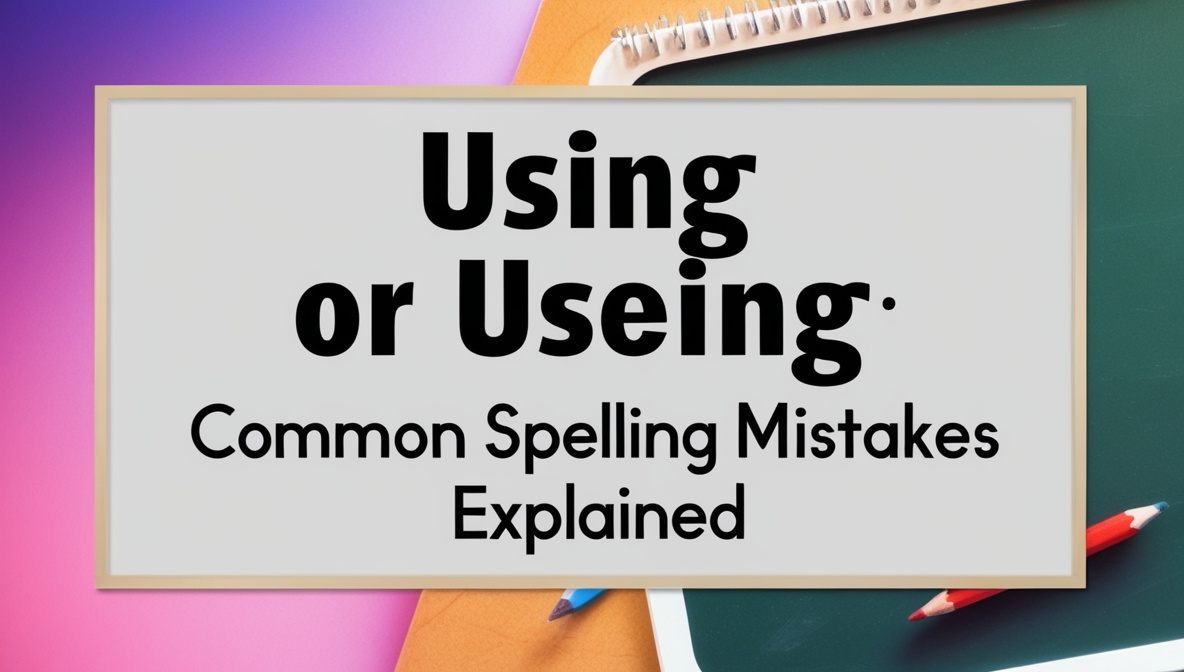Spelling can be a tricky aspect of the English language, and even seasoned writers can stumble over certain words. Among the most common mistakes are “using” and “useing.” While the first is correct, the latter is a misspelling that can lead to confusion. In this article, we’ll delve into the nuances of these words, providing scenarios to illustrate their proper use and helping you avoid the pitfalls of spelling errors.
Understanding the Basics
Before we dive into the complexities, let’s clarify the basic definitions of these words.
- Using: This is the correct form of the word. It is the present participle of the verb “use,” indicating the act of employing something for a purpose.
- Useing: This is a common misspelling. The correct form is “using,” and the error typically arises from misunderstanding the rules governing the addition of suffixes in English.
The Importance of Correct Spelling
Correct spelling is essential not only for effective communication but also for maintaining credibility as a writer. Spelling mistakes can distract readers and detract from the content. For instance, imagine reading a professional email that includes “useing” instead of “using.” Instantly, the writer’s authority may come into question.
Common Scenarios
To better understand the distinction, let’s explore some scenarios where these words might be used.
Scenario 1: Everyday Conversation
Imagine you’re chatting with a friend about a new software application. You might say:
“I am using this app to track my fitness goals.”
In this sentence, “using” clearly indicates that you are currently employing the app to achieve your goals. If you mistakenly said, “I am useing this app,” it would stand out as incorrect, disrupting the flow of conversation and making you appear less knowledgeable.
Scenario 2: Academic Writing
In an academic context, clarity is paramount. Consider this example from a research paper:
“The researchers were using a novel approach to analyze the data.”
Here, the correct use of “using” conveys a precise action in a formal setting. A typo like “useing” could undermine the professionalism of the paper and lead to misunderstandings about the research process.
Scenario 3: Professional Email
In a work-related email, you might write:
“We are using the new marketing strategy to improve our outreach.”
This sentence reflects a clear, professional tone. A misspelling like “useing” could prompt your colleagues to question your attention to detail, which is crucial in a business environment.
The Role of Context
The context in which you use “using” is vital for clarity. English is filled with homophones and words that sound similar but have different meanings. Keeping the context in mind can help you choose the correct spelling.
Recognizing Patterns
English spelling can be inconsistent, leading to confusion. However, there are patterns to recognize. For instance, when adding -ing to a verb, generally you just add “ing” to the base form, as in “walk” becoming “walking.”
In some cases, you double the final consonant if it’s preceded by a single vowel (e.g., “run” becomes “running”). However, in the case of “use,” the final consonant is not doubled, leading to the correct form “using.”
Tips to Avoid Misspellings
- Read Aloud: Reading your work aloud can help you catch mistakes. If it sounds off, it probably is.
- Use Spell Check: While not infallible, spell check tools can catch many common errors.
- Practice: Regularly writing and reviewing commonly confused words can help reinforce correct usage.
Why Do We Make These Mistakes?
Understanding why we make spelling errors can also be enlightening. Often, it boils down to a few key factors:
- Phonetic Confusion: Many English speakers sound words out phonetically, which can lead to errors.
- Overgeneralization: Some might apply rules to all words without considering exceptions, leading to mistakes like “useing.”
- Fast Typing: In our fast-paced digital world, typing quickly can result in typos that might go unnoticed.
The Impact of Spelling on Communication
The repercussions of poor spelling extend beyond mere embarrassment. It can impact your credibility, clarity, and even your relationships. In a professional setting, frequent spelling mistakes can lead to misunderstandings or a lack of confidence in your abilities.
Enhancing Your Writing Skills
To improve your spelling and overall writing skills, consider the following strategies:
- Read Widely: Exposure to well-written materials can help you internalize proper spelling and grammar.
- Engage in Writing Exercises: Regular writing practice can help you become more comfortable with spelling and grammar.
- Seek Feedback: Don’t hesitate to ask peers or mentors to review your work and provide constructive criticism.
Conclusion
In conclusion, the difference between “using” and “useing” may seem minor, but it carries significant weight in effective communication. By understanding the correct usage and being mindful of common spelling mistakes, you can enhance your writing and ensure your message is conveyed clearly.
Always remember to proofread your work, read it aloud, and maintain a keen awareness of your spelling. With practice and attention to detail, you can avoid the pitfalls of misspellings and communicate with confidence and clarity. Whether you’re writing a casual email or an academic paper, getting it right is essential. So, the next time you find yourself unsure about “using” or “useing,” you’ll know exactly which one to choose.

